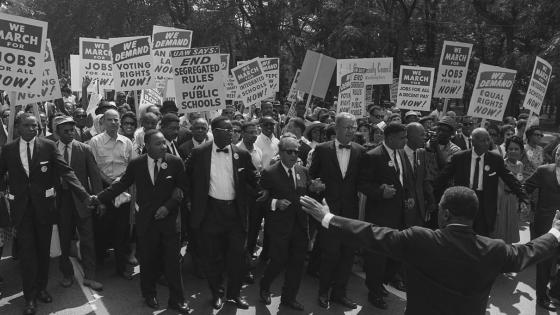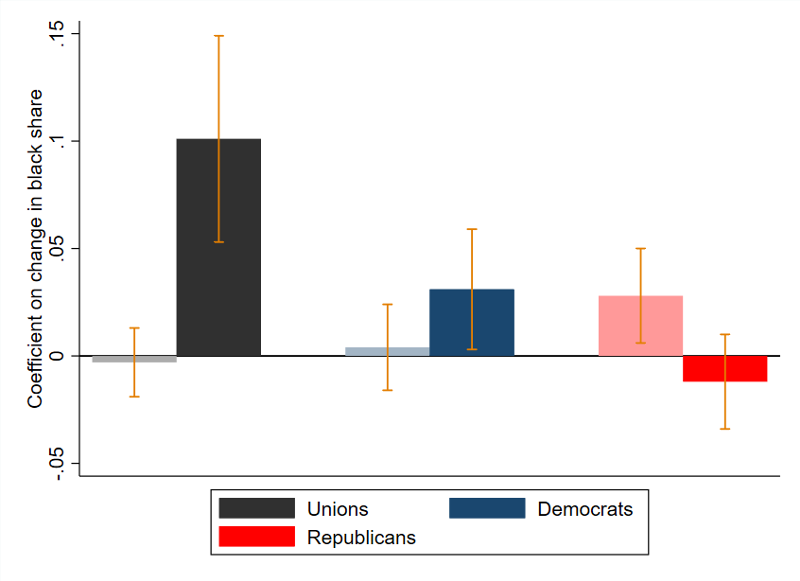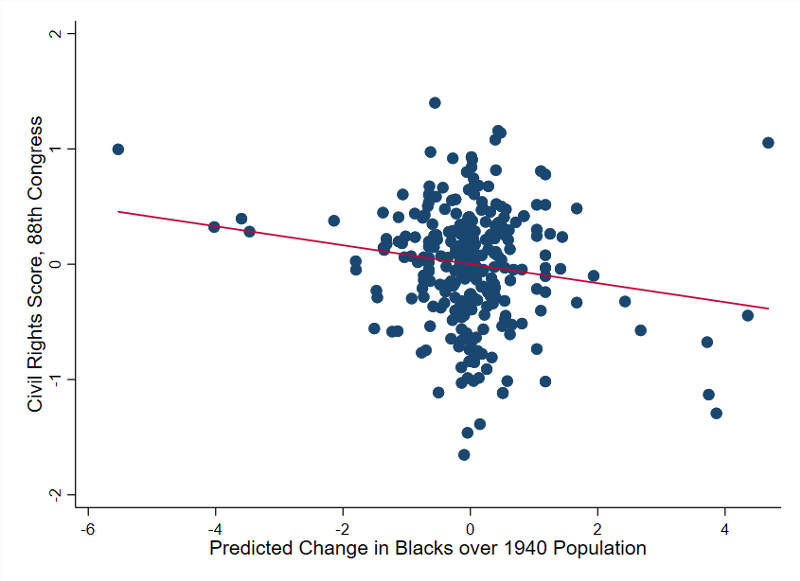Largely due to unprecedented migration waves, both Europe and the US have experienced a significant increase in racial and ethnic diversity in recent decades (e.g. Frey 2014 for the US; Hanson and McIntosh 2016 for Europe). This trend has reinvigorated the debate over the effects of diversity on demand for and supply of policies that promote or restrict inter-group equality.
On the one hand, as suggested by rising anti-immigrant sentiment across developed countries, interactions between minorities and members of the majority group can lead to hostile reactions, raising support for exclusionary political platforms (Halla et al. 2017, Dustmann et al. 2019). On the other hand, existing evidence indicates that cross-group interactions can, under certain circumstances, increase sympathy for minorities and foster social cohesion (Rao 2019, Schindler and Wescott 2017).
While most existing studies focus on the effects of diversity on preferences of the majority group, the size of minority groups – such as African Americans and Hispanics in the US – is often large enough to independently influence electoral outcomes and policies both at the local and at the national levels.
Our recent paper (Calderon et al. 2019) studies how changes in the racial profile of local constituencies affect both demand for and supply of policies aimed at promoting racial equality. We focus on a key episode in American history, namely, the Second Great Migration (henceforth, ‘Great Migration’) of African Americans. Between 1940 and 1970, more than 4 million blacks moved from the South to the North and West of the US, dramatically altering the racial composition of the country. While in 1940 only 25% of African Americans lived outside the US South, by 1970 this number had increased to 55% (Boustan 2016).
At the onset of the Great Migration, blacks were prevented from voting in most Southern states, but hardly any formal restrictions to black political participation existed in the North. Hence, the Great Migration had the potential to alter race relations in fundamental ways and change the political equilibrium in the North and West of the US both directly, through the inflow of new black voters demanding more racial equality, and indirectly, through changes in whites’ attitudes towards African Americans.
Interestingly, this very same period witnessed the struggle and the eventual success of the civil rights movement in eliminating de jure racial segregation and removing, at least formally, barriers to black political participation (Cascio and Washington 2014). In our paper, we ask if these two major events in US history – the Great Migration and the development of the civil rights movement – are causally related.
We exploit variation in black in-migration across non-Southern counties for the three decades from 1940 to 1970. Combining data from a variety of sources, we build on a large literature in the economics of migration (Card 2001, Boustan 2010) to overcome the potential concern that black migrants might have systematically moved to areas where support for civil rights was growing faster. In particular, we rely on settlements of southern-born African Americans living in the US North and West prior to the Great Migration in order to predict the number of black migrants from different Southern states received by each non-Southern county after 1940.
In the first part of the paper, we document that black inflows had a strong positive effect on demand for civil rights legislation. We measure support for racial equality with the share of votes received in Congressional elections by the Democratic Party, which by 1940 had unambiguously become the defender of blacks’ interests outside the South (Moon 1948, Schickler 2016). Black arrivals also increased the frequency of non-violent pro-civil rights demonstrations, as did the local presence of grassroots organisations such as chapters of the National Association for the Advancement of Colored People (NAACP). Our electoral results imply that a one percentage point increase in the black share of the population raised the Democratic vote share by almost 1.9 percentage points, or 5% relative to the baseline mean.
This is a large effect – even under the aggressive assumption that all black migrants immediately voted for the Democratic Party upon arrival, support for Democrats must have increased among white Northern residents because of black inflows. We provide direct evidence for this idea using historical survey data and measuring how whites’ attitudes towards civil rights and racial equality changed in response to the Great Migration.
Consistent with the electoral results, we find that, on average, black inflows increased demand for civil rights among whites. The granularity of survey data allows us to go one step further and explore the heterogeneity behind these average effects.
Figure 1 Probability that supporting civil rights is the most important issue for whites
Notes: The figure plots 2SLS coefficients (with corresponding 95% confidence intervals) on the change in the black share of the population. The dependent variable is a dummy equal to 1 if the respondent thinks that (support for) civil rights is the most important issue facing the country at the time of the interview. The first two bars refer to respondents who are not (grey bar) and who are (black bar) union members; the blue bars represent individuals who are not (light blue bar) and who are (dark blue bar) Democrats; and the red bars represent individuals who are not (pale red bar) and who are (red bar) Republicans.
Source: adapted from Calderon et al. (2019).
Figure 1 plots the relationship between black inflows and the probability that different groups of white respondents viewed support for civil rights as the most important issue for the country at the time of the survey. Black inflows are positively associated with support for civil rights among white members of labour unions and self-identified Democrats (black and dark blue bars, respectively).
However, this relationship is not evident for non-union members and non-Democratic respondents. In fact, black in-migration is negatively associated with support for civil rights among self-identified Republicans (red bar). In line with results presented in Figure 1, we also find that black inflows had a significantly larger impact on both the Democratic vote share and pro-civil rights demonstrations in places with a higher share of whites working in the unskilled and in the manufacturing sector, and where unionisation rates were higher.
One interpretation of these patterns is that formerly white labour unions formed a cross-race coalition with African Americans, joining them in their demand for racial equality. This may have happened either because unions sought to increase their political influence, as discussed in Schickler (2016), or because, by interacting with blacks in a specific context – the working environment – where they shared common goals and identity, union members changed their attitudes (Allport 1954). Once such a coalition was formed, its members may have been able to more effectively coordinate (Democratic) political campaigns, thereby attracting new white voters.
Another interpretation of our results, not in contrast with the previous one, is that black inflows increased the salience of civil rights among some segments of the white electorate, as originally envisioned by Gunnar Myrdal (1944) in his seminal contribution, The American Dilemma. In turn, higher awareness of the conditions prevailing in the South may have raised demand for racial equality among whites because of social and humanitarian considerations.
At the same time, our analysis indicates that some whites reacted negatively to the arrival of blacks in their neighbourhoods. First, the effects of black inflows vary inversely with the probability of inter-racial interactions in the housing market and with white homeownership rates. Second, as documented in Figure 1, survey data show that the arrival of African Americans was associated with cooler feelings towards racial equality among self-identified Republican respondents.
We analyse how northern legislators responded to changes in the composition and preferences of their constituencies. Summarising our main findings, Figure 2 plots the relationship between predicted changes in the black share of the population between 1940 and 1960 and the ideology of members of the House on racial issues at the end of the 88th Congress – the Congress that passed the Civil Rights Act (CRA) of 1964, one of the milestones of the civil rights movement.
This measure of ideology, constructed in recent work by Bateman et al. (2017), is based on the voting behaviour of legislators on civil rights bills and takes more negative values for more liberal ideology and positive values for more conservative.
Figure 2 Legislators’ ideology scores and black in-migration
Notes: The vertical axis reports the ‘agnostic’ version of the civil rights score from Bateman et al. (2017) for legislators representing the non-southern Congressional Districts in our sample during Congress 88. The horizontal axis reports the 1940-to-1960 predicted black in-migration over 1940 population. The figure reports the residual scatterplot of a regression of the civil rights scores against predicted black inflows, after partialling out state fixed effects, the 1940 black share of the population, and a dummy equal to 1 if the district was represented by a Democrat legislator in 1944.
Source: adapted from Calderon et al. (2019).
Figure 2 shows that legislators representing areas that received more African Americans between 1940 and 1960 had significantly more liberal voting records on racial issues at the end of the 88th Congress. These effects are quantitatively large. Comparing two legislators whose constituencies were respectively at the 75th and 25th percentile of black in-migration, civil rights scores of the former were 0.35 standard deviations lower (i.e. more liberal) than those of the latter.
Exploring the dynamics of the changes in legislators’ ideology, we find that the shift towards more liberal positions on racial issues took place almost entirely during the 1940s and was driven by areas that switched from the Republican to the Democratic Party. In contrast, during the 1950s, black inflows induced politicians of each party to move in opposite ideological directions, raising polarisation between parties.
When contrasted with other works on the political effects of migration, our results raise an intriguing set of questions. Under what conditions can migration and inter-group contact more broadly lead to the formation of cross-group coalitions? When, instead, is a backlash from original residents more likely to emerge?
In the specific context of the Great Migration and the civil rights movement, our evidence suggests that cross-race cooperation can emerge when individuals belonging to different groups share similar (in this context, more liberal) values, or when group members interact in domains, such as the working environment, where the emergence of a common identity and the existence of common goals can sustain political or social coalitions. At the same time, contact in other domains where groups compete over resources, such as the housing market, might lead to a backlash against minority group members.
References
Allport, G W (1954), The nature of prejudice, Addison-Wesley.
Bateman, D A, J D Clinton and J S Lapinski (2017), “A house divided? Roll calls, polarization, and policy differences in the US House, 1877-2011”, American Journal of Political Science 61(3): 698–714.
Boustan, L P (2010), “Was postwar suburbanization ‘white flight’? Evidence from the black migration”, The Quarterly Journal of Economics 125: 417–43.
Boustan, L P (2016), Competition in the promised land: Black Migrants in northern cities and labor markets, Princeton University Press.
Calderón, A, V Fouka and M Tabellini (2019), “Racial diversity, electoral preferences, and the supply of policy: The Great Migration and civil rights”, Harvard Business School BGIE Unit Working Paper No. 20-017.
Card, D (2001), “Immigrant inflows, native outflows, and the local labor market impacts of higher immigration”, Journal of Labor Economics 19(1): 22–64.
Cascio, E U, and E Washington (2014), “Valuing the vote: The redistribution of voting rights and state funds following the Voting Rights Act of 1965”, The Quarterly Journal of Economics 129(1): 379–433.
Dustmann, C, K Vasiljeva and A P Damm (2019), “Refugee migration and electoral outcomes”, Review of Economic Studies, forthcoming.
Frey, W H (2014), Diversity explosion: How new racial demographics are remaking America, Brookings Institution Press.
Halla, M, A F Wagner and J Zweimüller (2017), “Immigration and voting for the far right”, Journal of the European Economic Association 15(6): 1341–85.
Hanson, G, and C McIntosh (2016), “Is the Mediterranean the new Rio Grande? US and EU immigration pressures in the long run”, Journal of Economic Perspectives 30(4): 57–82.
Moon, H L (1948), Balance of power: The negro vote, Greenwood Publishing Group.
Myrdal, G (1944), An American dilemma: The negro problem and modern democracy, Harper and Row, Publishers.
Rao, G (2019), “Familiarity does not breed contempt: Generosity, discrimination, and diversity in Delhi schools”, American Economic Review 109(3): 774–809.
Schickler, E (2016), Racial realignment: The transformation of American liberalism, 1932–1965, Princeton University Press.
Schindler, D, and M Westcott (2017), “Shocking racial attitudes: Black GIs in Europe”, CESifo Working Paper 6723.








